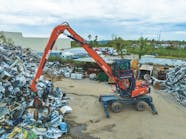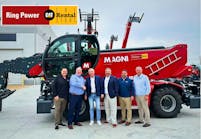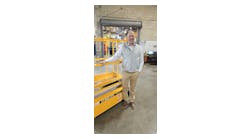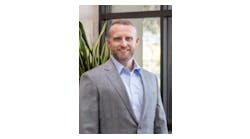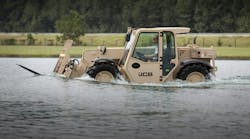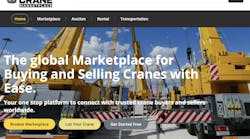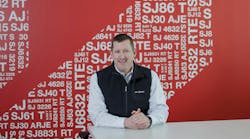The Participants:
Rob Messina, senior vice president of product development and product management, JLG Industries;
Simon Meester, president, Genie;
Malcolm Early, vice president, marketing, Skyjack Inc.;
Justin Kissinger, vice president, marketing, Hy-Brid Lifts;
Paul Jensen, product manager, Americas, Haulotte.
RER: What new equipment enhancements or developments has your company come up with in the past year?
Messina: JLG continues to focus on and invest in delivering equipment and technology solutions that help solve jobsite challenges. In the past year, we have worked to expand our product portfolio and offer modern enhancements to our existing lines. Many of these developments represent a significant change for the aerial equipment market, born from our commitment to understanding our customers’ jobsite challenges and partnering with them to develop solutions that deliver tangible benefits to their businesses. Every day we strive to put this belief into action, and the path to developing the 670SJ boom lift with self-leveling capability is an example of this.
This machine came as a result of our teams watching how boom lifts work on job sites and talking with operators that use this type of equipment every day. Many applications and working environments can be rather challenging for a traditional oscillating axle boom lift to work in because they are only rated to work on firm, level surfaces with five degrees or less of grade. And most job sites aren’t flat — nor will every job site have an improved surface.
To alleviate these challenges, the 670SJ is engineered to automatically adapt to terrain on slopes up to 10 degrees in any direction while driving with full functionality. Essentially, the boom lift’s chassis adjusts to the ground conditions — rather than having to adjust the ground conditions to the machine.
These features have directly led to significant productivity gains throughout the workday. For example, as operators have used our self-leveling boom lifts, they’ve told us that some of the advantages this technology offered them were:
· Fewer chances for dropped tools
· Operators and occupants were steadier during travel due to reduced bouncing of the unit as it traversed uneven terrain for improved operation and reduced fatigue
· Improved productivity translated to more work getting done
· Platform occupants’ fear of heights reduced because of a smoother ride
· Greater stability with operators reported feeling more secure while driving
The term innovation is thrown around so frequently in today’s day and age. However, true, game-changing innovation that improves safety and productivity like our self-leveling boom lift are few and far between. This product represents thinking outside the box to solve actual customer pain points, combined with years of fine-tuning and discovery alongside customers to bring to market a solution that will improve the way people work at height.
Another introduction in our boom lift line was the new Quad Tracks system for JLG 600S and 660SJ models, which offers operators increased machine utilization and flexibility for working on a range of surfaces, including sand, mud, gravel, grass, paved streets with curbs, potholes and sharp transitions.
We also had some notable additions to our scissor lift line-up, including four new rough-terrain and electric rough-terrain (ERT) scissor lifts in 40-foot and 47-foot models. The new RT4769 and ERT4769 represent the tallest machines in their class and provide users with access to five-story heights — an industry first. The new electric-drive JLG ES2646 and the hydraulic-drive R2646 slab scissor lifts have a 20-percent increase in capacity compared to competitive models in the size class, which allows users to carry more materials, like pipes and panels, as well as tools such as welders, to work at height.
And, we can’t forget the big announcement we made in our telehandler portfolio — the addition of the R1370, R1385 and R11100 rotating models. These three machines offer users capacities from 11,000- to 13,000-pounds and maximum reach heights of 67 to 97 feet. The R11100 model is JLG’s highest-reaching telehandler to date.
Meester: The electrification of our industry is a hot topic right now. We have continued to bring new, exciting hybrid/electric products, which our customers have responded very favorably to.
In May, we announced the industry’s first lightweight telescopic boom in the 60-foot height class. The S-60 DC all-electric boom and the S-60 FE hybrid boom are already available in Europe, the Middle East, Africa, and India, and will be available in North America in 2023. We’re excited about these products because they offer the cleaner, greener performance that our customers and many jobsites are looking for and need. They also perform as well if not better than their diesel counterparts, and they are cost-effective to own and operate.
Then, in August, Terex and Genie announced a Series A investment in Columbus, Ohio-based Acculon Energy, which designs electrification solutions for non-automotive applications. Genie already has demonstrated decades of leadership in electric power in the aerial industry, and this investment in Acculon makes sure we will remain an industry leader in developing quality, next-generation solutions.
And, although I can’t say anything more right now, you can expect more to come from Genie before the year is over.
Early: The last 12 months have been quite busy. While OEMs are continuing to face challenges in supply chain and logistics the rental market has remained positive, and demand is increasing. It has definitely been an opportune time to launch new products.
Skyjack launched the first of those new products with our next generation vertical mast lifts. Following the launch of the award-winning SJ20 E, the new SJ12 E and SJ16 E provide a quiet and versatile package with zero emissions. With a new mast design, direct AC electric drive, drivable at full height, and fewer hydraulic connection points, the SJ12 E, SJ16 E, and SJ20 E boast an increased duty cycle by up to 30 percent.
Secondly, we saw that it was an unfortunate and commonplace practice for operators to stand on railings to gain a little more height to access small areas. For example, standing on the railings to obtain access through suspended ceiling tiles. Skyjack’s XStep helps eliminate this dangerous practice and maximizes reach and productivity by providing operators with safe, increased access into and around tight, restricted spaces and avoids the elevated risk of falling from the platform.
The XStep consists of a swing down base with full height railings that, in turn, is securely mounted on the mid-rails of the scissor lift. Suitable for the current generation of SJ3215 and SJ3219 DC scissors, as well as retrofittable to previous Skyjack DC scissor models and can easily be moved between units, further increasing fleet flexibility. The operator can step up (48cm) into the XStep, close the top rail and work safely gaining extra jobsite access. Important in the design has been the ability for one person to install the XStep in just five minutes without the requirement of special tools or lifting equipment.
To round out the year, we looked at our telehandler range. Initially launched in 2015, Skyjack offers six models within core classes of telehandlers throughout North America. The new changes are a direct result of customer and operator feedback.
While we have made one-off changes to our TH Series throughout the years, these are the first significant design changes that we have done since launching. In doing so, we feel we have increased the return on our customer’s investment by improving reliability, and serviceability.
The core changes include:
· A significant change in the tilt compensation cylinder configuration to utilize a dual cylinder design, to better distribute the load and improve reliability.
· A new high-pressure filter has been added to the hydraulic system to complement the oil return filter and further reduce the risk of contamination.
· The main boom pivot bearings have been updated to greaseless bearings, removing the need for end users to grease and maintain on job sites; and,
· Highly durable steel cowlings have been introduced. These are highly durable for better onsite protection and are also easier to repair.
Kissinger: Our newest development is a heavy-duty pipe rack for our A92.20 Pro Series scissor lifts, which improves safety and productivity of operators. Without a manufacturer-certified pipe rack, operators didn’t have a safe way to bring pipe up to their working location. While we have had various pipe racks for prior generations of our scissor lifts, which were designed for a specific need of the customer, we created a new design and tested it to current standards. The new design provides up to 300 pounds of capacity without reducing the total platform capacity, simplifies installation, doesn’t require any counterweights, and is positioned so that it is not obtrusive to the operator.
Jensen: This year, Haulotte is upgrading its compact range of electric scissor lifts. The five new rugged models have been redesigned to ensure a maximum utilization rate, increased safety and simplified maintenance. They integrate the group’s high-quality standards and meet all the requirements for working at heights from 20 to 39 feet on all types of stabilized ground. All models are equipped with the newly designed guardrails that feature thicker stock. The easily foldable guardrails come standard on all compact models.
Scissor operators will love the way the new AC motors respond to control inputs. The proportional controls ensure smooth and precise movements even when working and maneuvering at full height. Compact scissors are equipped with Haulotte Activ’Energy Management. The intelligent Canbus charger constantly monitors battery parameters to ensure optimal charging. It also incorporates dedicated charging cycles for battery maintenance (desulfation, equalization, etc.). To reduce maintenance costs and efforts, the system can be fitted with centralized watering solutions, either manual or automatic.
RER: Any new achievements or developments in safety equipment or accessories?
Messina: As with our product development efforts, JLG has continued to evolve its safety equipment and accessories offerings. One example of this was JLG announcing a developmental partnership with RE2 Robotics in early 2022. This collaboration of our two companies is to advance the integration of robotics with access equipment to deliver improved operator safety and enhanced productivity on job sites.
The initial project the companies are working on together is to produce a remote-controlled aerial lift, with no platform, to install solar panels, which represents the first real step toward autonomous aerial lifts. We’re still in the early stages, although there’s a tremendous interest in maturing this type of technology in the construction space because if we can be successful here, there’s a clear case for a robot in this application.
Meester: One benefit of electrification is that electrifying equipment doesn’t just reduce or eliminate emissions, it also helps reduce and eliminate hydraulic leaks, which can be a headache on jobsites, and costly to clean up. In fact, over the next few years, we expect to see more all-electric solutions that will eliminate leaks completely. We’re not quite there yet, because the solutions aren’t always cost-effective — it has to be the right solution at the right time. But that is the direction we are heading.
Our E-Drive scissor lifts already almost completely eliminate the risk of hydraulic leaks, but one of our other new innovations announced this year, the Lift Tools Spill Guard, is an economical, easy-to-maintain hydraulic containment system that offers additional protection to eliminate the risk of hydraulic leaks.
Early: Covered in question one, the XStep offers:
· All round fall protection.
· Access to controls.
· Simple installation.
· Increased productivity.
Suitable for the current generation of SJ3215 and SJ3219 DC scissor, as well as previous Skyjack DC Scissor models, it can easily be moved between units, further increasing fleet flexibility.
Kissinger: We just released the heavy-duty pipe rack, which will allow operators to safely lift pipe to height. Additionally, we have several projects in the works to increase jobsite safety and productivity for the operators and will help improve dealers ROI. These new projects will be released at The ARA Show in 2023.
Jensen: Haulotte has led the industry in secondary guarding technology for boom lifts with the innovative Activ’Shield bar. Now we are bringing a new secondary guarding device that is perfectly integrated into the upper control box and detects the driver’s position and movements in real time using lidar technology. A warning light and audio announcements, available in 13 languages, inform the operator of the system’s status. In dangerous situations, the machine stops immediately and restricts forward movements.
Obviously longer lead times have been a major concern for rental companies with some saying they are waiting a year or even two years for some machines. What steps are you taking to try to reduce these long lead times?
Messina: Right now, an ongoing challenge we face as a manufacturer is the constrained supply chain, and longer lead times for our customers are a result of this. We are beginning to see signs of stabilization in some categories and anticipate that the whole ecosystem will continue to normalize in the coming year. But right now, demand continues to outweigh supply in many categories, and it is a headwind the entire industry is still working through.
Through this, we’ve learned that we need to become more geographically adaptive and agile. We are working to improve the supply chain resiliency of our products by finding and qualifying additional sources of supply in multiple regions across the globe.
For rental businesses concerned with longer lead times, one thing they can do to help OEMs shorten lead times is to forecast their product needs and secure build slots from manufacturers as soon as possible.
Meester: This, obviously, has been one of the biggest challenges this year, and last year. Not just for Genie, but for all equipment manufacturers. Unfortunately, there is not one silver bullet solution; it’s a multitude of different kinds of material categories and often multiple supply tiers deep. Not to mention the logistics and freight challenges. We’ve been deeply engaged with our suppliers to constantly work on solutions and alternatives. We’ve also been working to expand our supply base. And our engineering teams have done a great job of being innovative and, where it’s been possible and made sense, redesigning for the components that are available.
Early: The post-COVID-19 situation represents probably one of the most challenging business environments the access manufacturing business has known. During COVID we used to think we were in unprecedented times yet two years on we see daily challenges that just seem to keep on coming. The issue of availability is compounded by rising costs, global logistic issues, and labor availability. Then one adds another layer with geo-political events such those in Ukraine – energy surcharges, China’s zero-COVID policy with associated lockdowns, and Sri Lanka, an important supplier of the industries’ tires.
Costs and prices have increased, and new issues arise daily. As a business we have seen our backlog for 2022 and 2023 continue to grow. We have daily conversations with customers on lead times, which unfortunately are increasing.
Ultimately, this is means we are looking at our manufacturing footprint with a view to increasing capacity and having an in the market for the market approach with shorter and more flexible supply chains.
Jensen: Supply chain shortages have been a big challenge across nearly every industry for the past two years. Haulotte has been working very closely with our suppliers to keep a steady flow of equipment onto the production lines. Our engineering and R&D teams have been working hard to find alternate component solutions that meet Haulotte’s high standards so we can minimize the delays as much as possible. Although we still have lead times that are longer than we would like, we have also seen record production volume numbers as we work hard to bring those lead times down.
RER: Costs of machines have increased significantly in the recent past? What has led to this cost increase and are you doing anything to try to reduce the cost of new units?
Messina: Insufficient supply, excessive demand, labor shortages, plus escalating raw material and logistics costs, are certainly all factors influencing market dynamics right now. Our focus at JLG continues to be delivering the best possible product to our customers, and to manage these complexities, we are working to improve the forecast of our demand signals and are collaborating with the supply base on these signals.
Meester: Like everyone else, we’re facing strong inflationary pressures coming from material cost, freight/logistic constraints, energy cost, disruption in our operations, etc. We have aggressively tightened our own belts to give our customers as much cover as possible but inflation of this magnitude, which we haven’t seen in 40 years, is simply too much to absorb through cost actions alone.
Early: Yes, every issue we face, whether it be availability or logistics or labour, comes with significant cost increases. We have always tried to limit “pass-on” but in today’s environment it is just not practical. While we have increased prices, it far from covers the increased costs we are faced with.
On a day-to-day basis, we face changes down to a component level and are spending significant time and cost at looking for alternatives, testing alternatives, and issuing engineering changes. In the meantime, we are looking at our manufacturing footprint and an "in the market for a market" approach.
Kissinger: There have been a lot of variables that have led to price increases, which is a result from supply chain disruptions to steel prices due to the Ukraine war to high inflation. We are always reviewing our suppliers, sourcing alternative parts, and redesigning our lifts to keep the cost of our lifts down.
Jensen: Pressures to increase prices seem to have come from every angle. Between inflation, supply chain shortages, and transportation challenges just to name a few, we’ve all seen prices grow. Although we have had to increase our pricing at Haulotte, we have as much as possible been able to honor the pricing that we agreed to when the purchase order was signed and accepted. That means that to date, we haven’t applied any surprise surcharges or last-minute price increases no matter how long the lead time. We’ve rewarded our customers that stick with us through these challenges with the respect of sticking to our agreements and we hope to continue to do so. We also must strike the right balance so we can maintain the profitability required to provide effective technical and parts support to our customers and machines after the sale. We value our long-term relationship with customers and defend a win-win situation that benefits both parts.
RER: Have you made any improvements that make machines easier to maintain?
Messina: Our approach to making machines more efficient to maintain is a twofold solution.
First, we continue to incorporate new technologies that evolve and modernize our products, including the ability to service and maintain them. For example, when we introduced the AE1932 DaVinci lift in 2021, it was engineered as the first-of-a-kind all-electric lift — it has zero hydraulics to eliminate the potential for leaks and is powered by a single lithium-ion battery that recharges as the lift descends to lengthen the operational time between charges. These innovations offer our customers machines that require reduced maintenance, adding up to substantial cost-of-ownership savings.
Second, we have also introduced many new tools and accessories that enhance service technicians’ experience with our products. For instance, the Inspection Assistant in JLG’s next-generation Augmented Reality App increases efficiency by providing inspection details and in-depth information on-demand right on the technicians’ mobile devices. The new DaVinciGO app provides intelligent diagnostics through their smartphones or tablets, allowing techs to view, diagnose and troubleshoot the DaVinci lift in real-time, from any location. And, our Handheld Analyzer gives technicians remote access to program, troubleshoot, calibrate or customize JLG equipment performance.
As technology continues to change the way service technicians work, JLG has gone further to offer on-demand access to our library of 3-D hydraulic schematics, available on our Online Express portal. These interactive renderings can help techs troubleshoot hydraulic issues by helping techs locate and trace a circuit to its functions on any JLG boom lift, scissor lift or telehandler model.
Meester: The short answer is: Yes, we have made improvements that make machines easier to maintain and will continue to look for ways to simplify maintenance without sacrificing performance or quality. And electrification itself helps as well, of course, because with fewer moving parts, you’ll have less wear and tear.
The longer answer involves some recent examples of innovations in our boom, scissor lift and telehandler families that simplify maintenance, making it easier and less expensive both in terms of time and money. The design of our S-60 J and S-80 J boom lifts, for example, has been simplified and optimized so that they can deliver the performance and quality our customers expect from Genie with fewer parts that need serviced, maintained and replaced. Our AC electric drive motors, which you’ll find in our E-Drive scissor lifts, and in many of our DC electric and FE hybrid boom lifts, are brushless and fully sealed, which means they are also maintenance-free. And finally, we didn’t leave telehandlers out of this equation either. Our GTH-1056 telehandler can come equipped with a 74 hp, DEF-free engine option, which is a low-maintenance solution that also delivers better fuel efficiency than a higher horsepower engine, but with performance similar to a telehandler with a higher horsepower thanks to the transmission gearing.
Early: Skyjack became an industry leader by providing machine features that combine durability, quality, and serviceability, making our products world renowned for product reliability. Our team understands the importance of maximum uptime, so our equipment is designed to provide just that. All major service points are easily accessible, enabling straight-forward troubleshooting and repairs.
I mention above in Question 1 some of the changes we made to our telehandler range that epitomize this approach.
Our new vertical mast range now features a new mast design. The multi-stage hydraulic cylinder and inverted multi-section mast with overlaps helps increase rigidity. The new design is free from any chains, sheaves, or bushings to reduce maintenance burden. The larger section at the top of the design prevents debris ingress. Like previous Skyjack vertical masts, the Next Generation models keep the telescopic mast at the rear, which provides a totally unrestricted view from the front-facing control box. This layout also moves the steering wheels away from the mast, which offers excellent maneuverability with zero inside steering radius.
Kissinger: When we originally designed the Hy-Brid Lift product line our goal was to make the lifts quick and simple to maintain and 18 years later that is still our design philosophy. An example is instead of using hydraulics for driving and steering, we went electric, which significantly simplifies the hydraulic system. By only using hydraulics for lifting there isn’t a need for an oil filter or a need to change the oil periodically. Another benefit of the simplified hydraulics was that it simplified our LeakGuard design for leak containment on jobsites. Our design only requires one tray, which can contain 100 percent of the hydraulic oil. Additionally, dealers can upgrade the wet cell batteries to maintenance free batteries to further reduce maintenance.
Jensen: The new compact scissor lifts have been designed to facilitate routine maintenance operations; components are easily accessible, electrical and hydraulic elements have been separated, and the routing of hoses has been carefully designed to avoid the risk of friction and leaks. Renowned for their performance and reliability, asynchronous motors require no routine maintenance. The scissors have been subjected to rigorous endurance tests to guarantee their ruggedness.
Compact scissors embed a number of diagnostic solutions to facilitate troubleshooting and reduce downtime. The Haulotte Activ’Screen on-board diagnostic tool gives access to machine parameters and provides key information about the machine’s status in real time. These features are also available via the Haulotte Diag mobile application, which also offers advanced diagnostics with detailed resolution procedures.
The Sherpal telematics solution allows remote diagnosis of machines. It considerably reduces downtime by providing remote access to fault codes and recommending actions. The telematics data helps make sure technicians have the right parts on the truck so more repairs are completed on the first visit, reducing downtime.
The Activ’Energy Management tool allows complete control over battery maintenance, and thus can significantly reduce maintenance costs.
RER: Are electric machines and/or alternative fuel machines more in demand these days and what is your company doing to address that need in the marketplace?
Messina: Industrywide, interest in electric products is rapidly increasing due to continued pressure to find more non-fossil fuel-based solutions. We expect to see demand for these types of machines continue to gain popularity as battery technology advances and environmental considerations become more and more stringent.
To address this, JLG continues to work on projects that will add more electrified solutions and model options to our robust portfolio of electrified products.
Meester: More than 70 percent of Genie’s product portfolio is already electrified, which has been a 20-year journey in the making. Genie is not new to this. Technologies that enable electrification, including batteries, are evolving rapidly. We can’t sit still. We need to keep pushing ourselves. The venture with Acculon will help ensure we continue to deliver quality equipment with the right technology for our customers into the future.
Early: Yes, the subject of electrification is a hot topic. Although I am tempted to say we ought to remember that as an industry, zero-emission DC scissors have led the way for many more years than the duration of the recent debate. At Skyjack the DC scissor and vertical mast are also undergoing change. In our case we introduced our vertical mast with electric drive, and we will see that feature, and its benefits, flow though our other DC-based product ranges.
Returning to internal combustion machines and alternatives such as hybrid and electric, we have teams working on these areas.
Looking more broadly, and more from the viewpoint of sustainability, rental companies and major contractors face increasing demands for sustainability information. This, in part, stems from government initiatives (and budgets) that see sustainability at the core of construction projects, including the use of sustainable machines. Skyjack has introduced its Eco mark to support our customers by providing products that deliver benefits in environmental performance and long-term sustainability
Kissinger: Hy-Brid Lifts have always done electric machines as they are more power efficient, quieter, and require less maintenance.
Jensen: In 2018 Haulotte introduced the electric Pulseo range of machines with the first all-electric 60-foot articulating boom to the worldwide market and committed to providing an electric alternative for all of our internal combustion engine-powered machines. Last year we released 43- and 53-foot electric rough terrain scissor lifts that featured a removable range-extending generator. Haulotte has new announcements on the horizon as we continue to demonstrate our commitment to our 2018 promise.
The marketplace has received our electric product solutions very well. The Pulseo range has been successful not only in global regions with environmental mandates banning the use of combustion engines. Haulotte electric machines are also finding success on indoor projects by solving worker safety and productivity challenges while providing large platforms and weight capacities on which to perform the work.
Are there any other trends you’re expecting to see in MEWPs in the near future?
Messina: Electrification is a major trend that we expect to see grow in the future as urban environments with stringent regulatory requirements target carbon footprints. Not only have we seen urbanization resulting in less open space on and between job sites, which has driven greater demand for high-reach equipment with a compact footprint, but we also see it creating a socio-economic impact. As younger and younger generations enter the system, they demand more social responsibility from an environmental standpoint. As urbanization has increased people’s awareness of environmental issues, there are now more emission-free zones and a call for more fossil fuel independence from a geopolitical standpoint, driving greater demand for electrification.
New tools and solutions are being used to create “moments of autonomy” with aerial equipment, continuing to advance the connected job sites of today and build the smart cities of the future. In some cases, this is happening through practical and digestible features and applications like AR and mobile control apps, and in other instances, we are now seeing the integration of robotics with MEWPs. While these innovations won’t replace humans, they might be used to complete repetitive tasks and particularly hazardous environments where we don’t want to put people.
As we look to the future of MEWPs and the aerial industry, JLG is focused on delivering solutions to what our customers need to grow their business and what they want to solve real-world job site challenges. Our customer-centric approach drives our development efforts ensuring that we are offering products that provide real value. We do this by paying attention to what others are trying, keeping an open mind when we are evaluating opportunities and investing the time and resources needed to bring innovative solutions to the market.
Meester: Digitization is certainly another trend in the industry right now. It is certainly playing a key role in helping equipment owners maintain and manage their fleets more efficiently, and it’s also helping take jobsite productivity to the next level. And we’re still just at the surface of what will be possible once we have fully digitized job sites’ value streams.
Early: Sustainability will continue to develop. Geographically we see it more in Europe than North America, but as we see more government initiatives and frankly money coming with a sustainability character, we would expect to see that need grow. As this happens, I think there is a discussion to be had on infrastructure. Not unlike the evolution in electric vehicles. It is all very well having an electric machine, but on a site without a substantial electric supply would the current solution be a conventional fuel-based generator? The rental industry (and OEMs) has some thinking to do. We are used to charging DC scissors. How will facilities need to change to charge booms? It takes 10 minutes to pour diesel into a boom; how will longer charging times be accommodated? I think the conversation will move more away from electrification of the machine and more to the electrification of our industry.
